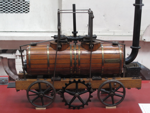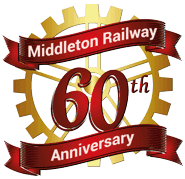Once the Running Shed had been fitted out, the final stage of the project to build it was to have a grand opening ceremony. As is often the case with such opening ceremonies, this took place some considerable time after the shed had begun to be used, since this had been during December 2017, for preparing the locomotives that were operating the Santa Specials. The opening ceremony then took place more than six months later, on 21st July 2018.
The opening ceremony was performed by Councillor Judith Blake, the leader of Leeds City Council, and we had invited all those who had contributed to the project - either financially or by volunteering during the construction of the building. The response had been considerable, and so a good crowd had gathered in the area just outside the Engine House, as shown in the picture below.
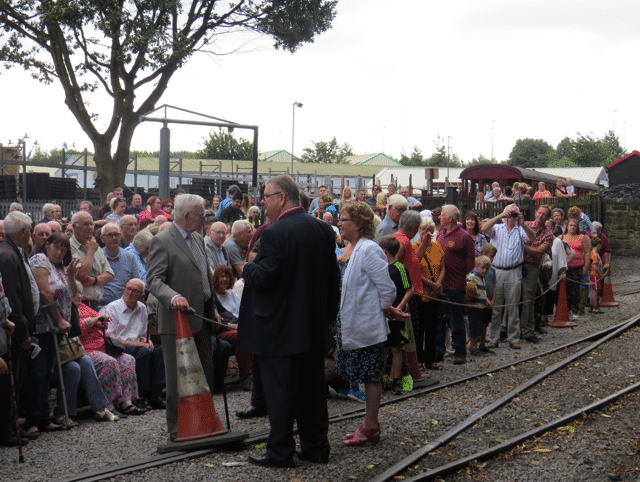
Looking towards the platform, and part of the crowd attending the ceremony, who were gathered outside the Engine House and the Running Shed. In the foreground, on the track side of the rope barrier, are (from left to right) Don Townsley (a Vice President of MRT), Ian Smith (a Vice President of MRT) and Councillor Judith Blake.
Picture © Janet Auckland, 2018.
Ian Smith, one of our Vice Presidents, acted as master of ceremonies, and began with some brief safety information, mainly warning people to be careful of the two pits if they visited the Running Shed. He then introduced Councillor Judith Blake, as shown in the two pictures below.
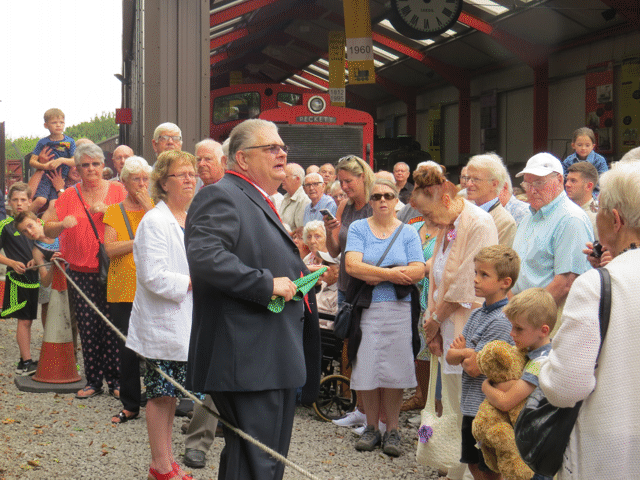
Ian Smith introducing Councillor Judith Blake, with the Engine House behind them.
Picture © Janet Auckland, 2018.
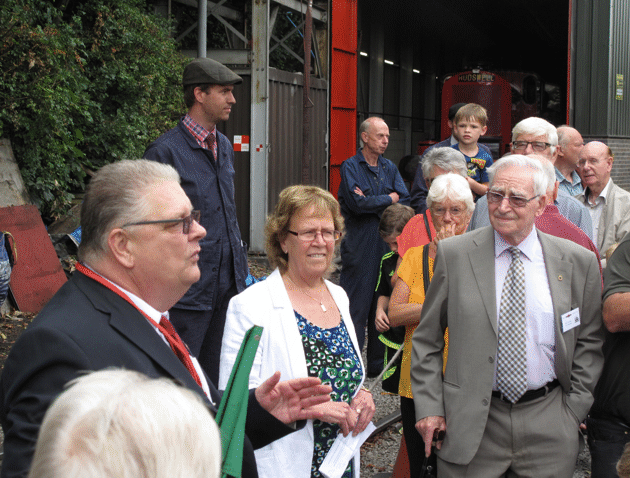
Ian Smith introducing Councillor Judith Blake, with Don Townsley to the right of her, and behind them the Running Shed and a couple of our volunteers who were crewing the locomotives.
Picture © Tony Cowling, 2018.
Councillor Judith Blake then made a speech, explaining briefly the significance of the Running Shed to the railway, and the significance of its location on the former alignment of the old Middleton Light Railway, which had been part of Leeds City Tramways. She then went on to encourage the crowd to congratulate all of the volunteers who had been involved in the project to construct the Running Shed.
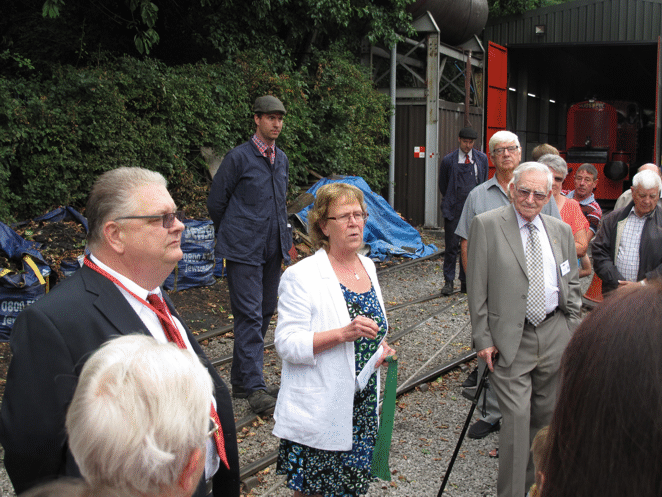
Councillor Judith Blake making her speech, and being listened to attentively by Ian Smith, Don Townsley, some of our volunteers and part of the crowd.
Picture © Tony Cowling, 2018.
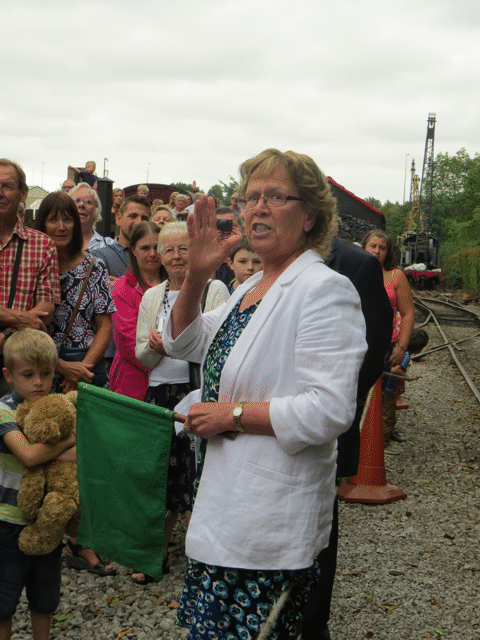
Councillor Judith Blake making her speech, and encouraging the audience to congratulate all of the volunteers who had worked on the Running Shed project.
Picture © Janet Auckland, 2018.
Following her speech, Councillor Judith Blake then waved the green flag to signal to the drivers of the two locomotives that they should bring them out of the Running Shed.
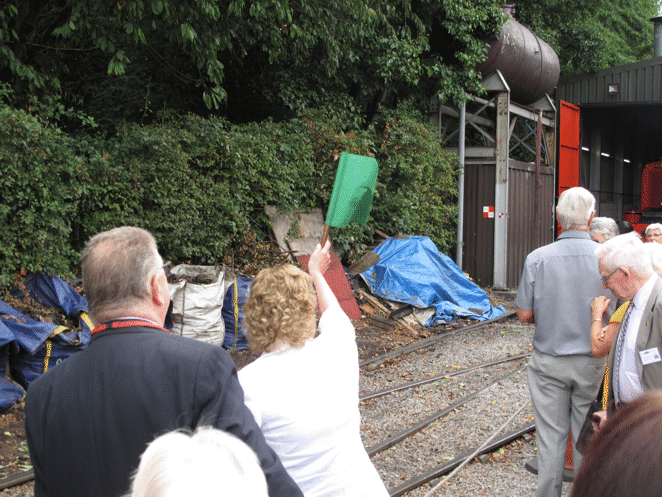
Councillor Judith Blake signalling to the drivers of the locomotives to leave the Running Shed.
Picture © Tony Cowling, 2018.
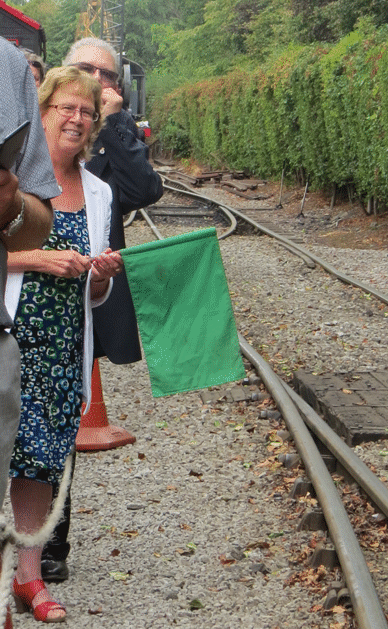
Almost a driver's-eye view of Councillor Judith Blake signalling to them to bring the locomotives out of the Running Shed.
Picture © Janet Auckland, 2018.
At this point somebody suggested to Councillor Judith Blake that she really ought to have a whistle as well as a green flag, and so one was immediately provided.
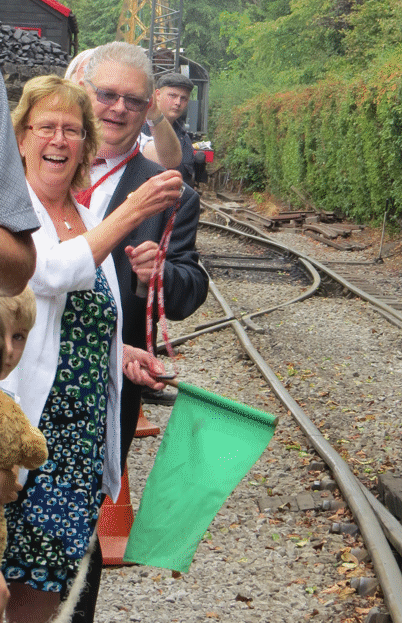
Councillor Judith Blake, now with whistle as well, signalling to the drivers to bring the locomotives out of the Running Shed.
Picture © Janet Auckland, 2018.
The first of the two locomotives to emerge was the Hudswell Clarke diesel D577 Mary.
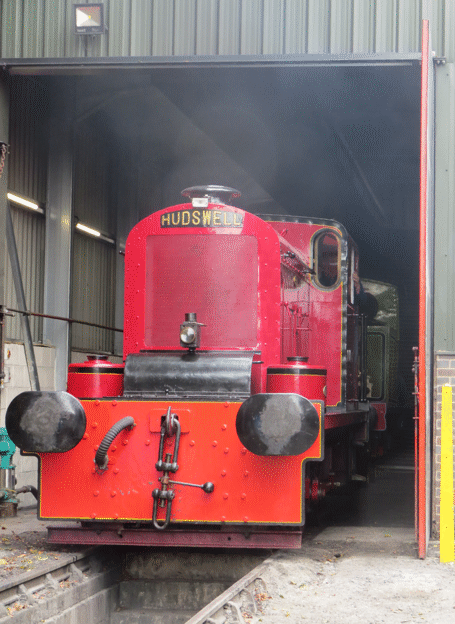
HC D577 Mary emerging from the Running Shed.
Picture © Janet Auckland, 2018.
As Mary ran past the crowd it was greeted enthusiastically, at least by those who were not occupied in taking photographs of it! It then ran forward past the coaling stage and out onto the passenger line, and then ran back through the loop and coupled on to the rear of the passenger train.
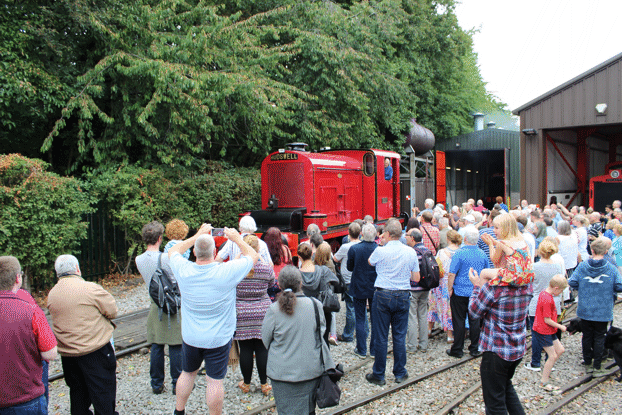
HC D577 Mary making its way past the crowd towards the coaling stage.
Picture © Andrew Gill, 2018.
The second of the two locomotives involved in the ceremony was the steam locomotive NER 1310, and the two pictures below show it following Mary out of the Running Shed.
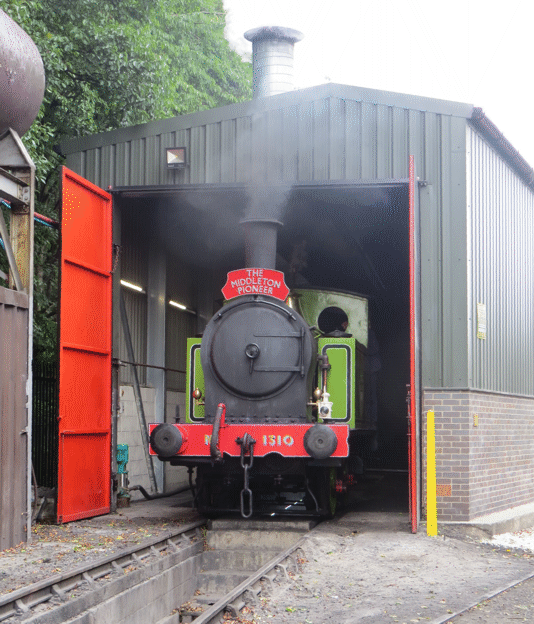
NER 1310 emerging from the Running Shed.
Picture © Janet Auckland, 2018.
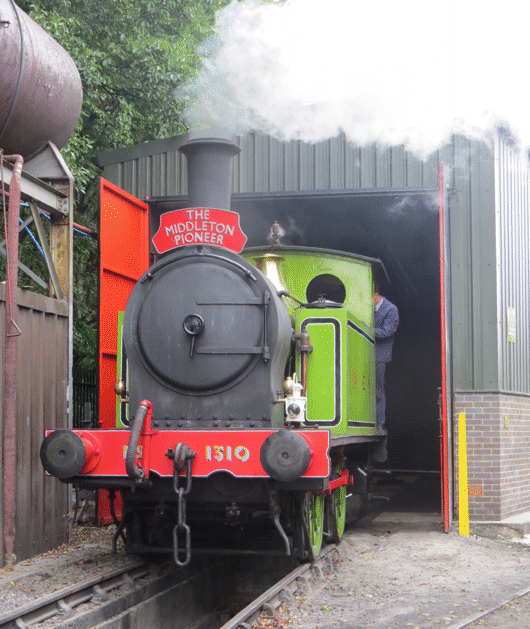
NER 1310 emerging from the Running Shed.
Picture © Janet Auckland, 2018.
NER 1310 was also greeted enthusiastically by those in the crowd who were not busy taking photographs of it. As shown in the two pictures below, it too ran forward as far as the coaling stage, but then it reversed back and returned to the Running Shed.
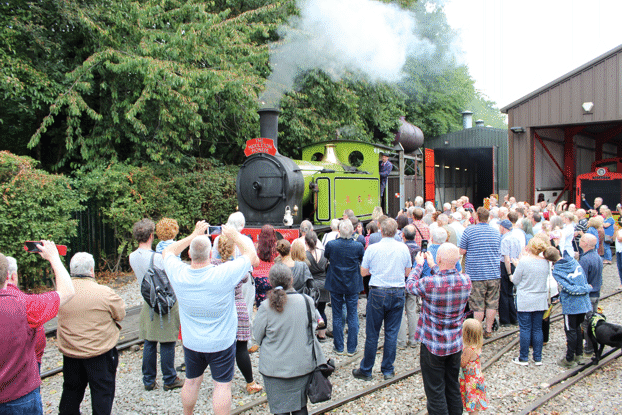
NER 1310 making its way past the crowd towards the coaling stage.
Picture © Andrew Gill, 2018.
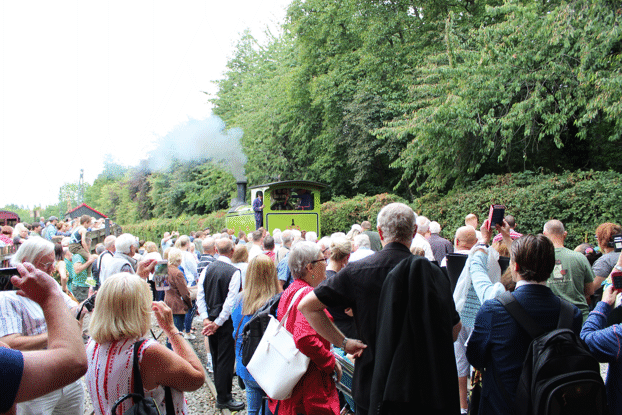
NER 1310 almost at the coaling stage, before reversing back into the Running Shed.
Picture © Andrew Gill, 2018.
Once NER 1310 was back in the Running Shed, then many of the crowd came to inspect the shed, and in particular to look at the engraved bricks on the outside wall. Others went for lunch, while quite a number went for a ride on the train. This included Judith Blake and her fellow councillors, and the two pictures below show them on the locomotive which was at the front of the train, namely Hudswell Clarke D1373 MD&HB No. 45.
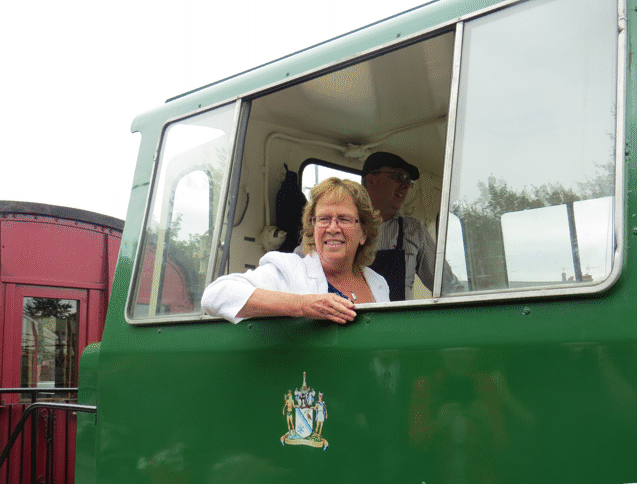
Judith Blake in the cab of HC D1373, with the driver standing behind her.
Picture © Janet Auckland, 2018.
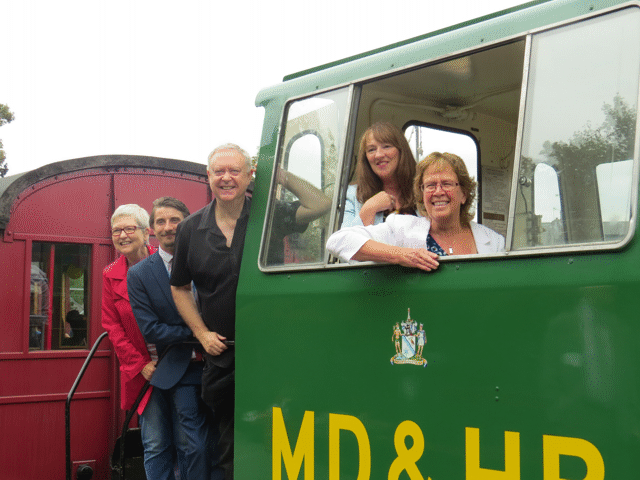
The team of local councillors on the footplate of HC D1373. From left to right, they are: Councillor Al Garthwaite, Councillor Paul Wray, Councillor Paul Truswell, and (in the cab of the locomotive) Councillor Kim Groves and Councillor Judith Blake.
Picture © Janet Auckland, 2018.
This not only completed the ceremony, but also the whole of the project. From the initial decision to start, which had been taken in May 2013, it had taken just over 5 years. This may sound like a long time for a building that holds just two locomotives, but not only did we have a railway to run at the same time as we were building it, but also we were constructing another building (in connection with our HLF-funded project to acquire and conserve the David Monckton collection of locomotives), and overhauling one of these locomotives too. Other sets of project pages will tell you about the Picton shelter building and the overhaul of Brookes No. 1.
Given that all this was going on as well, we think that we did quite well!
Go back to the previous stage in this project.
Return to the overall description of this project.
More Information
Other pages about this project and the "Buy a Brick" appeal:
- An overview of the project and the appeal;
- The "Buy a Brick" appeal;
- The structure of the project;
- The progress with the project;
- The construction of the pit;
- Design and site preparation;
- Construction of the foundations;
- Erection of the framework;
- Construction of the walls and roof;
- Fitting out.
Other pages provide more information about:

